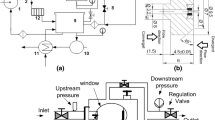Abstract
We present a new method of extracting information on average vapor distribution in a cavitating flow based on statistical processing of PIV data for a liquid phase. For this, vectors on instantaneous velocity fields are analyzed over the entire statistical ensemble of instantaneous realizations considering their status: valid—vectors that passed validation procedures, outliers—the ones with incorrect values, out-of-flow—those calculated on insufficient number of seeding particles (tracers), masked—they correspond to unilluminated flow regions. The suggested approach is based on the two basic principles: absence of the tracers in the vapor phase and statistical independence of the successive measurements. The case study is performed for a cavitating 2D symmetric hydrofoil under unsteady cloud cavitation conditions with regular shedding of large-scale cloud cavities. Comparing statistical distribution laws in different flow regions makes it possible to recognize the stable sheet cavity and its pulsating part and determine the location of cloud cavity detachments. This approach for PIV data analysis is shown to be an effective tool to characterize time-averaged distribution of the dispersed phase in cavitating flow based merely on velocity measurements for the liquid phase. Using it allows one to substantially reduce consumption of computational resources and save time when investigating the structure of cavitating flows, limiting to standard PIV measurements in liquid. This method can be also applied to analyze the structure of other types of dispersed two-phase flows.
Graphical abstract














Similar content being viewed by others
References
Adrian RJ, Westerweel J (2010) Particle image velocimetry. In: Shyy W, Yang V (eds) Cambridge aerospace series, vol 30, 1st edn. Cambridge University Press, Cambridge, p 586 (ISBN 978-0521440080)
Bhatt A, Ganesh H, Ceccio SL (2021) Cavitating flow behind a backward facing step. Int J Multiph Flow 139:103584–11. https://doi.org/10.1016/j.ijmultiphaseflow.2021.103584
Chernoff H, Lehmann EL (1954) The use of maximum likelihood estimates in χ2 tests for goodness of fit. Ann Math Stat 25(3):579–586. https://doi.org/10.1214/aoms/1177728726
Cramér H (1999) Mathematical methods of statistics. In: Griffiths PA, Mather JN, Stein EM (eds) Princeton mathematical series, vol 9. Princeton University Press, Princeton, p 575 (ISBN 978-0691005478)
Cochran WG (1954) Some methods for strengthening the common χ2 tests. Biometrics 10(4):417–451. https://doi.org/10.2307/3001616
Foeth EJ, van Doorne CWH, van Terwisga T, Wieneke B (2006) Time resolved PIV and flow visualization of 3D sheet cavitation. Exp Fluids 40(4):503–513. https://doi.org/10.1007/s00348-005-0082-9
Ge M, Zhang G, Nematikourabbasloo N, Fezzaa K, Coutier-Delgosha O (2021) Application of fast synchrotron X-ray imaging in velocimetry of cavitating flows. In Proceedings of the SNAME 26th offshore symposium, Virtual, pp (SNAME-TOS-2021–15)–8. https://doi.org/10.5957/TOS-2021-15
Gopalan S, Katz J (2000) Flow structure and modeling issues in the closure region of attached cavitation. Phys Fluids 12(4):895–911. https://doi.org/10.1063/1.870344
Huang B, Young YL, Wang G, Shyy W (2013) Combined experimental and computational investigation of unsteady structure of sheet/cloud cavitation. ASME J Fluids Eng 135(7):071301–16. https://doi.org/10.1115/1.4023650
Kravtsova AY, Markovich DM, Pervunin KS, Timoshevskiy MV, Hanjalić K (2014) High-speed visualization and PIV measurements of cavitating flows around a semi-circular leading-edge flat plate and NACA0015 hydrofoil. Int J Multiph Flow 60:119–134. https://doi.org/10.1016/j.ijmultiphaseflow.2013.12.004
Mann HB, Wald A (1942) On the choice of the number of class intervals in the application of the chi square test. Ann Math Stat 13(3):306–317. https://doi.org/10.1214/aoms/1177731569
Maurice G, Machicoane N, Barre S, Djeridi H (2021) Coupled X-ray high-speed imaging and pressure measurements in a cavitating backward facing step flow. Phys Rev Fluids 6(4):044311–15. https://doi.org/10.1103/PhysRevFluids.6.044311
Pennings PC, Westerweel J, van Terwisga TJC (2015) Flow field measurement around vortex cavitation. Exp Fluids 56(11):1–13. https://doi.org/10.1007/s00348-015-2073-9
Tassin AL, Li C-Y, Ceccio SL, Bernal LP (1995) Velocity field measurements of cavitating flows. Exp Fluids 20(2):125–130. https://doi.org/10.1007/BF01061590
Timoshevskiy MV, Churkin SA, Kravtsova AYu, Pervunin KS, Markovich DM, Hanjalić K (2016) Cavitating flow around a scaled-down model of guide vanes of a high-pressure turbine. Int J Multiph Flow 78:75–87. https://doi.org/10.1016/j.ijmultiphaseflow.2015.09.014
Timoshevskiy MV, Ilyushin BB, Pervunin KS (2020) Statistical structure of the velocity field in cavitating flow around a 2D hydrofoil. Int J Heat Fluid Flow 85:108646–11. https://doi.org/10.1016/j.ijheatfluidflow.2020.108646
Wei Z, Zang B, New TH, Cui YD (2016) A proper orthogonal decomposition study on the unsteady flow behaviour of a hydrofoil with leading-edge tubercles. Ocean Eng 121:356–368. https://doi.org/10.1016/j.oceaneng.2016.05.043
Acknowledgements
The new method of statistical analysis of PIV images was developed with funding from the Russian Science Foundation (Project No. 19-79-30075). The experiment on the cavitating hydrofoil was financially supported by the Ministry of Science and Higher Education of the Russian Federation (Project No. 075-15-2019-1923). The automated methods of data acquisition and processing used in the study were realized under a state contract with IT SB RAS.
Author information
Authors and Affiliations
Corresponding author
Additional information
Publisher's Note
Springer Nature remains neutral with regard to jurisdictional claims in published maps and institutional affiliations.
Rights and permissions
About this article
Cite this article
Pervunin, K.S., Timoshevskiy, M.V. & Ilyushin, B.B. Distribution of probability of the vapor phase occurrence in a cavitating flow based on the concentration of PIV tracers in liquid. Exp Fluids 62, 247 (2021). https://doi.org/10.1007/s00348-021-03344-y
Received:
Revised:
Accepted:
Published:
DOI: https://doi.org/10.1007/s00348-021-03344-y




